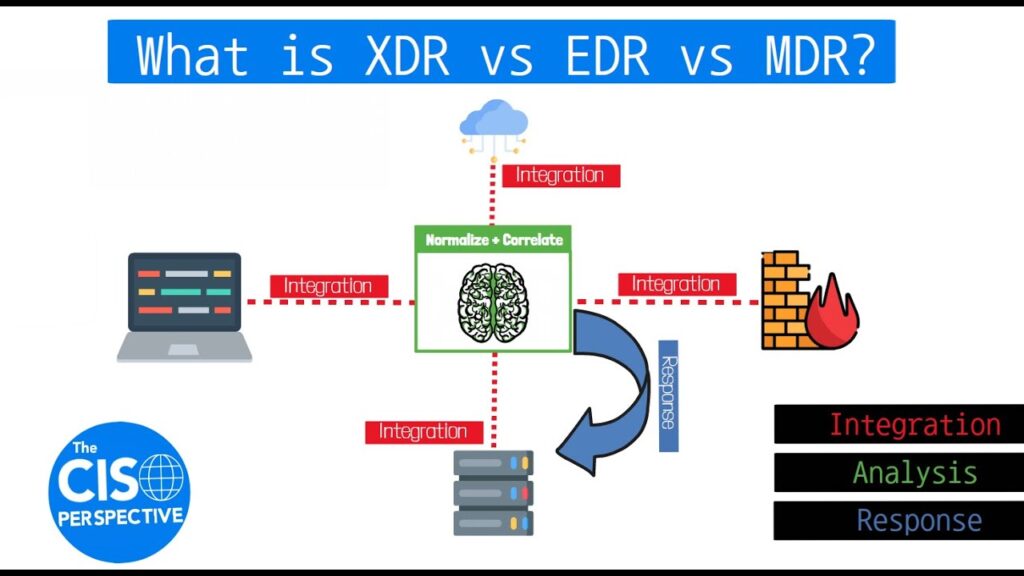EDR systems capture and prioritize alerts for action, filtering out false alarms so that only relevant threats are detected quickly and effectively, enabling security teams to respond swiftly and effectively.
Today’s enterprise security teams must contend with an overwhelming torrent of data and disjointed tools that create an alert overload. XDR uses heuristics, analytics, and automation to combine these sources and extract insight for improved visibility and productivity instead of siloed tools.

What is EDR?
EDR (Electronic Data Retrieval) refers to tools designed to continuously monitor endpoints for signs of cyber threats and respond accordingly. By providing businesses with visibility of existing or emerging threats that evade traditional protection mechanisms like antivirus (AV) and sandboxing solutions, EDR offers businesses an effective tool against potential damage and future attacks.
EDR tools can quickly alert teams and stakeholders when threats are identified and take predetermined actions based on predefined triggers to stop or contain attacks in their tracks – for instance, isolating affected endpoints to stop malware spread or stopping an attack as soon as it begins. Furthermore, these tools collect information regarding threats that are returned to a central monitoring system for review.
EDR solutions also utilize file analysis tools that flag files that pose risks or exhibit suspicious activity, enabling cybersecurity professionals to examine all threats thoroughly and clarify how they gained entry to the network.
Depending upon an organization’s needs, data type stored on endpoints, and unique business risks, EDR solutions may either be deployed internally or offered as managed service from cybersecurity vendors and partners (known as managed EDR or mEDR). In the former instance, this approach can reduce deployment and support costs for organizations with limited resources and in-house expertise, with dedicated teams of cybersecurity specialists analyzing threats on customers’ behalf.
What is XDR?
XDR is an advanced solution designed to detect, investigate, and respond to threats across multiple security layers. Eliminating silos and providing one pane of glass across your entire security ecosystem helps streamline detection capabilities while optimizing SOC performance.
Traditional security approaches focusing solely on one layer generate an overwhelming volume of alerts that require time and resources to investigate and remediate, placing undue strain on analysts while leading to costly false positives and slow incident response times. With XDR, inefficiencies can be mitigated by providing a central command center that integrates anonymized data and threat intelligence for protection from all kinds of cyberattacks.
In addition to gathering alerts from various security layers, XDR conducts root cause analysis on detected threats. This provides a timeline and path of how they gained entry to your organization, spread through its network, and attacked each endpoint. Furthermore, it may help uncover attack vectors attackers use to bypass detection, such as exploited vulnerabilities or stolen authentication credentials.
XDR makes this visibility and investigation possible by collecting telemetry from remote users, networks, endpoints, servers, and cloud workloads. This offers analysts curated detections, comprehensive investigations, and highly correlated threat events, enabling them to work more quickly, smarter, and efficiently.
What is MDR?
EDR technology targets endpoints to detect and identify suspected threats, yet the threat landscape is ever-changing. Where traditional tools may catch certain types of malware easily, APTs can bypass detection due to their range of attack methods and tactics.
Detecting and mitigating cyber threats has become more difficult as their complexity has grown exponentially. At the same time, many security teams need help with event overload, skill shortages, narrowly focused tools, lack of integration, and insufficient time to investigate every alert received properly.
XDR goes beyond EDR in providing increased visibility and protection by integrating data from different security domains – such as endpoint, network, and cloud environment data to provide comprehensive awareness of the cyber landscape. Furthermore, its machine learning and AI capabilities help identify unknown types of malware more quickly, reducing false positives that require manual investigation by security teams.
Managed detection and response (MDR) services provide organizations without the budget or staff resources necessary for setting up their own internal Security Operations Center (SOC), continuous threat monitoring, investigation, remediation, or triage with 24/7 monitoring services provided by MDR providers – saving customers both time and effort when responding to incidents.
What is MDR vs XDR?
EDR and XDR are useful tools, but each organization’s needs depend on IT infrastructure, budget, and security goals. Before choosing either tool or service for their organization, they must take an assessment approach to assess these criteria carefully.
EDR produces massive volumes of alert data, requiring extensive review to weed out false positives and recognize actual threats. This requires cybersecurity teams to dedicate considerable time and expertise to this task – which MDR provides as part of their managed offering, alleviating them of this responsibility for analysis and response to cyberattacks.
Full-service MDR solutions combine human expertise and technology to proactively hunt down threats, monitor IT infrastructure, and act quickly when detected. MDR providers can also assist businesses in prioritizing threats accordingly to maximize their security budget effectively.
Extended detection and response (XDR) solutions differ from traditional EDR by gathering information from multiple endpoints across an IT infrastructure, thus increasing visibility into any threats or attack vectors that would otherwise go undetected. This enables extended detection and response solutions to identify hidden threats or attack vectors that might otherwise go undetected.
XDR solutions can be deployed as software-as-a-service (SaaS), cloud-based systems to reduce costs and avoid disruptions while supporting open standards and APIs to avoid vendor lock-in. This gives organizations more flexibility in selecting their preferred detection and response solution.
